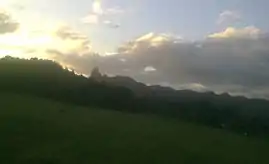Joske's Thumb
Joske's Thumb is a precipitous volcanic plug that rises in the skyline to the west of Suva, Fiji. It is located 15 kilometers west of Suva and its base is accessible from Naikorokoro Road, which connects Naikorokoro Village to Queens Road.[3] Other sources note that Naikorokoro Road, the road toward Joske's Thumb, intersects on the north side of Queens Road, 0.8 kilometres (0.50 miles) west of the Lami Bay Hotel outside Lami.[4]
| Joske's Thumb | |
|---|---|
 Panorama showing Joske's Thumb: June 2013 | |
| Highest point | |
| Elevation | 1,450 ft (440 m) [1] |
| Coordinates | 18°5′17.84″S 178°18′10.04″E [2] |
| Geography | |
 Joske's Thumb | |
Sir Edmund Hillary, the mountaineer made famous for being the first climber (with his Sherpa guide Tenzing Norgay) confirmed as having reached the summit of Mount Everest in Nepal, was defeated in his first attempts to reach the peak of Fiji's Joske's Thumb.[5][6] Sir Hillary was conscripted into the Royal New Zealand Air Force during World War II. He served as a navigator aboard Catalina flying boats in New Zealand's No. 5 Squadron based at the flying boat base in the Suva Point neighborhood, currently the location of the University of the South Pacific's Lower Campus.[7] He made two attempts to climb Joske's Thumb, the first of which ended before reaching the base of the mountain, due to heavy undergrowth. In his autobiography, Sir Hillary wrote about his second attempt to climb Joske's Thumb while stationed in Suva: "We had come up the wrong side — underneath the ball of The Thumb.... Bitterly disappointed at being rebuffed I was much too conscious of the 400-foot (120-metre) drop below me to take any more risks — and I hadn't much confidence in our length of clothes line. The Thumb had beaten us again."[6] In 1983, 30 years after his successful Everest expedition, he reached the summit of Joske's Thumb along with several members of the Fiji Rucksack Club.[8][9]
The peak takes its name from Paul Joske, one of Suva's pioneer settlers, who came with the Australian-based Polynesia Company in 1870. Joske and his son, Adolf Brewster-Joske, later known as Adolf Brewster Brewster,[10] established Fiji's first sugar mill, importing machinery and beginning the country's sugar industry. The mill, which operated between 1873 and 1875, was on the site where Fiji's Parliament Building currently stands. The mill ultimately failed, owing to the poor crop from shallow soil in the Suva area. Later in life, Paul Joske devoted much of his time to designing and establishing Suva as Fiji's new capital.[11]
Prior to Paul Joske's arrival in Fiji, the mountain was known as "Rama" and Devil's Thumb,[12] because "the locals say looks like a man trying to claw his way out of hell."[11] When Paul Joske committed suicide after allegations of incest, his descendants changed their names to Brewster, Joske's wife's maiden name, but the Devil's Thumb was commemorated with Joske's name, due to his demise.[13]
Today, the mountain and the area around Joske's Thumb are known as a habitat for many species of birds. Among the species that live near Joske's Thumb are many birds that are endemic to Fiji, including the masked shining parrot, the giant forest honeyeater,[14] and the pink-billed parrotfinch,[15] although parrotfinch sightings have declined significantly since the area was logged in the early 1980s.[16] Joske's Thumb is also a historical nesting site for Falco peregrinus nesiotes, Fiji's endemic peregrine falcon.[17]
Along with the Grand Pacific Hotel in Suva, Joske's Thumb is featured on the reverse side of the 2007 and 2012 series of Fiji's ten dollar bill.[18]
References
- Wright, A.C.S. (1965). The soil resources of the Fiji Islands. Suva, Fiji: Government of Fiji. p. 21. Retrieved 5 June 2013.
- Puebla, Gael (25 March 2012). "Coordinates from photograph: "View from just below the summit. End of the usual hike."". Panoramio. Retrieved 14 June 2013.
- Stanley, David (2001). Fiji. Avalon Travel Publishing. pp. 195. ISBN 1566913365.
- Koeppel, Richard (1915). "Birding Fiji". Abstract of the Proceedings of the Linnaean Society of New York City. Retrieved 5 June 2013.
- Greenop, Matt (11 January 2008). "World's media honours Hillary". The New Zealand Herald. Retrieved 30 May 2013.
- Hillary, Edmund (1975). Nothing venture, nothing win. Coward, McCann & Geoghegan. pp. 50–55. OCLC 1299239. Retrieved 5 June 2013.
- "USP: Laucala Campus Map". University of the South Pacific. Retrieved 5 June 2013.
- Kate, Talebula (7 March 2013). "Essay contest for Sir Edmund". Fiji Sun. Retrieved 30 May 2013.
- "2013 National Essay Competition". The Fiji Association in Auckland (Inc). Retrieved 6 August 2014.
- "A.B. Brewster photograph album". Cambridge University Library: Royal Commonwealth Society Library. Janus. Retrieved 30 May 2013.
- Wright, Ronald (1986). On Fiji Islands. New York: Viking. p. 29. OCLC 564636584. Retrieved 5 June 2013.
- Brewster, Adolph Brewster (1937). The King of the Cannabal Isles: A Tale of Early Life and Adventure in the Fiji Islands. Fiji: Robert Hale. p. 58. OCLC 557720362.
- Schütz, Albert James (1978). Suva - A History and Guide. Sydney: Pacific Publications. ISBN 9780858070356. OCLC 6086396. Retrieved 5 June 2013. Alt URL
- "Joske's Thumb Pictures of Suva". SouthPacificPhotography.com. Retrieved 5 June 2013.
- "Species factsheet: Erythrura kleinschmidti". BirdLife International. Retrieved 5 June 2013.
- "Erythrura kleinschmidti". IUCN Red List of Threatened Species. Archived from the original on 25 September 2013. Retrieved 5 June 2013.
- Clunie, Fergus (December 1972). "A contribution to the natural history of the Fiji peregrine" (PDF). Notornis. 19 (4). Retrieved 5 June 2013.
- Fiji new 2012 flora and fauna series confirmed BanknoteNews.com. January 30, 2013. Retrieved on 2013-02-04.